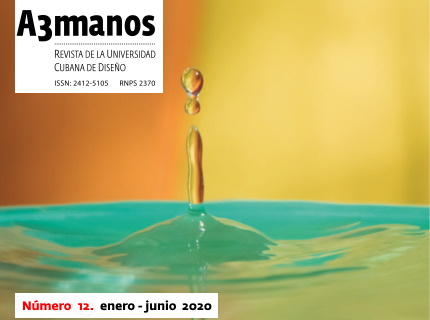Design as a response to the sustainable future and global trends.
##plugins.themes.bootstrap3.article.main##
Abstract
The work deals with the relevance of a prospective vision in professional practice, research and education in design, and proposes that global macro trends be considered as catalysts of the major guidelines that will have a short and long term impact on the future of the Latin America, that operates in a global environment and the knowledge era. This will allow design education and professional practice to be oriented, not only to the main problems and situations that will prevail in the region but also to have a design intervention with a holistic point of view and a transdisciplinary work dynamic.
##plugins.themes.bootstrap3.article.details##

This work is licensed under a Creative Commons Attribution-NonCommercial-ShareAlike 4.0 International License.
- Attribution — You must give appropriate credit , provide a link to the license, and indicate if changes were made . You may do so in any reasonable manner, but not in any way that suggests the licensor endorses you or your use.
- NonCommercial — You may not use the material for commercial purposes .
- No additional restrictions — You may not apply legal terms or technological measures that legally restrict others from doing anything the license permits.
- ShareAlike — If you remix, transform, or build upon the material, you must distribute your contribution under the same license as the original. NOTE: This point applies to numbers 1 to 20 of the magazine with the previous CC-BY-NC-SA 4.0 license. Does not apply to the new CC BY-NC 4.0 license from Volume 11, Number. 21 (2024).
References
ABEL, B., EVENS, L., & KLAASSEN, R. (2011). Open Design Now: Prefase. Waag Society: Nederland.
ANDERSON, C. (2012). Makers. The New Industrial Revolution. Crown Bussiness: New York.
BROWN, T., & WYATT, J. (2010). Design Thinking for Social Innovation. Stanford Social Innovation Review, Winter, 2010
BROWN, T. (2008). Design Thinking. Harvard Bussiness Review, Paperback Serie.
CADENA, ANDRÉS y otros (2011), Building globally competitive cities: The key to Latin American growth, McKinsey Global Institute. Disponible en: www.mckinsey.com/insights/urbanization/building_competitive_cities_key_to_latin_american_growth
CASTELLS, Manuel (1999). La era de la información. Economía, sociedad y cultura. México: Siglo XXI Editores.
CÓRDOBA-CELY, CARLOS y otros. (2014). Innovación social: aproximación a un marco teórico desde las disciplinas creativas del diseño y las ciencias sociales. Tendencias. 2, segundo semestre 2014. Universidad de Nariño. Colombia.
EBERSTADT, NICOLAS. (2011), “World Population Prospects and the Global Economy”, American Enterprise Institute, Disponible en: www.aei.org/files/2011/02/28/EberstadtAEIDevelopmentPolicyWorkingPaperFINA
FAO (Organización de las Naciones Unidas para la Alimentación y la Agricultura) (2009), “Cómo alimentar al mundo en 2050”, presentado en la Cumbre Mundial sobre Seguridad Alimentaria, celebrada en Roma, Disponible en: www.fao.org/fileadmin/templates/wsfs/docs/synthesis_papers/Cómo_alimentar_al_mundo_en_2050.pdf.
FULTON SURI, J. (2005). IDEO. Chronicle books. California.
GIBBONS, M., LIMOGES, C., NOWOTNY, H., SCWARTZMAN, S., SCOTT, P., & TROW, M. (1994). La nueva producción del conocimiento. Pomares Corredor: Barcelona.
GIBBONS, MICHAEL. (1998) Pertinencia de la educación superior en el siglo XXI. Banco Mundial. www.humanas.unal.edu.co/contextoedu/.../gibbons_victor_manuel.pdf
HOWE, NIEL Y RICHARD JACKSON (2011), Global Aging and the Crisis of the 2020s, Centro de Estudios Estratégicos e Internacionales, Disponible en: http://csis.org/files/publication/110104_gai_jackson.pdf
IDEO (2dn Edition). Human-Centered Design Toolkit. Second Edition. IDEO: USA. Disponible en: http://www.ideo.com/work/human-centered-design-toolkit/
LEADLEY, P., H. M. PEREIRA y otros (2010), “Biodiversity Scenarios: Projections of 21st century change in biodiversity and associated ecosystem services”, Secretaría del Convenio sobre la Diversidad Biológica, Montreal, Serie Técnica No 50. Disponible en: http://www.diversitasinternational.org/activities/research/biodiscovery/cbdts50en.pdf
LEYDESDORFF, L. (2000). The triple helix: an evolutionary model of innovations. Research Policy 29 (2).
MANUAL DE OSLO (2005). Guía para la recogida e interpretación de datos sobre innovación. Tercera Edición. OECD: UE. ISBN 84-611-2781-1.
MANZINI, E. (2015). Cuando todos diseñan. Una introducción al diseño para la innovación social. Experimenta. Madrid.
PUENTES LAGOS, DAVID y otros. (2012). Tendencias en diseño y desarrollo de productos desde el factor humano: una aproximación a la responsabilidad social. Iconofacto 9 (12), Medellín.
RODRÍGUEZ, A., & ALVARADO, H. (2008). Claves de la innovación social en América Latina y el Caribe. Comisión Económica para Amércia Latina y el Caribe (CEPAL). Naciones Unidas: Santiago de Chile.
ROTHWELL, R. (1994). Towards the fifth-generation innovation process. International Marketing Review, 11(1).
UNESCO. (2014). Declaración de Aichi-Nagoya sobre la Educación para del Desarrollo Sostenible. Conferencia Mundial Aichi-Nagoya (Japón), 10-12 de noviembre. Reuniones de las partes interesadas Okayama (Japón), 4-8 de noviembre.






















